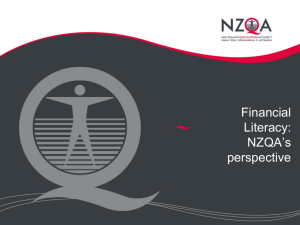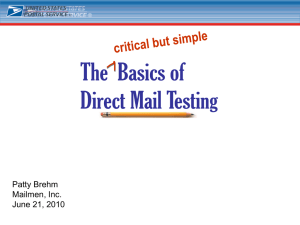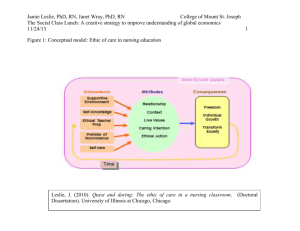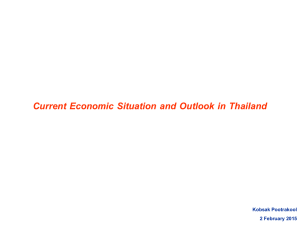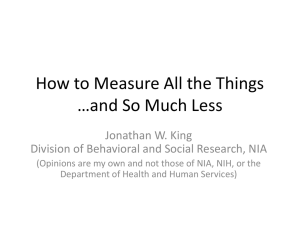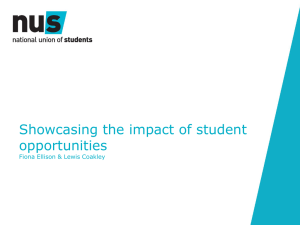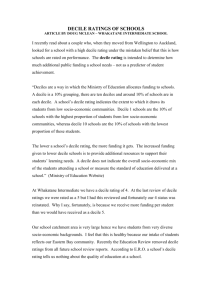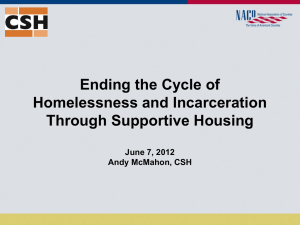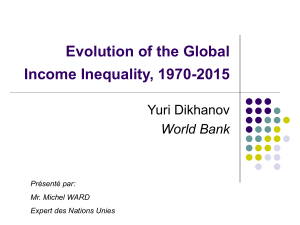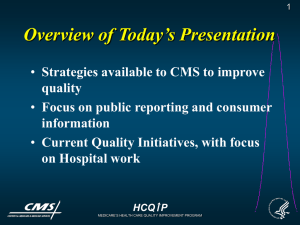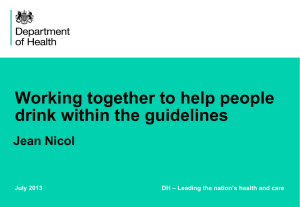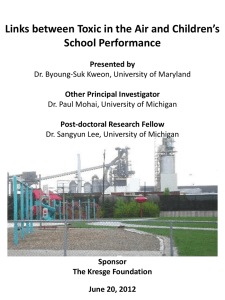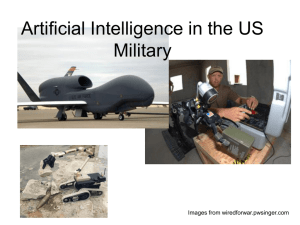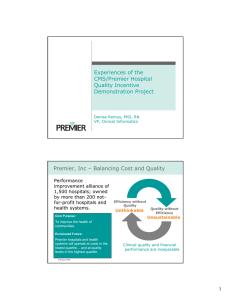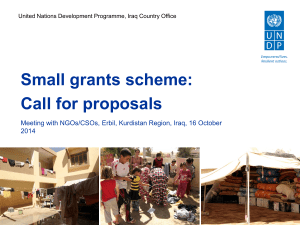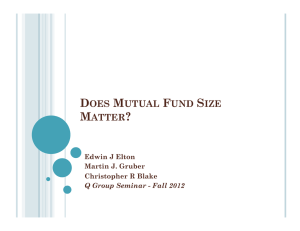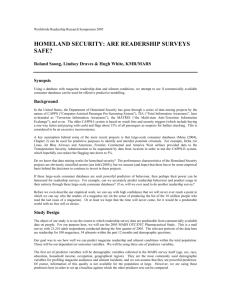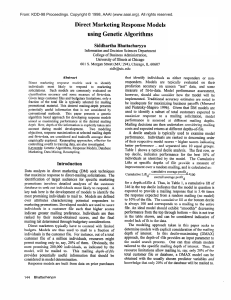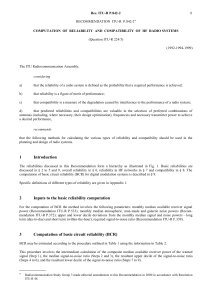Drivers of Food Security
advertisement
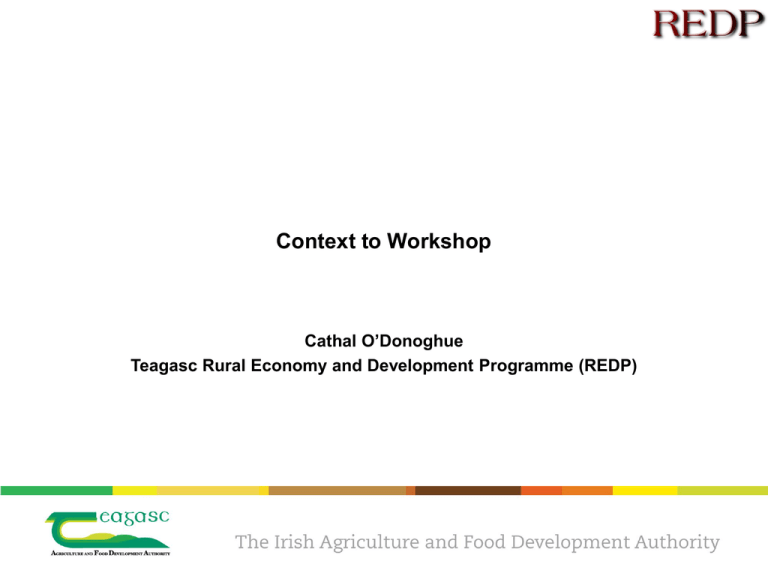
Context to Workshop Cathal O’Donoghue Teagasc Rural Economy and Development Programme (REDP) Objective The motivation for the event is To help Public Agri-Food Institutions to develop their strategy in relation to the engagement with Food Security issues in Developing Countries. The meeting serves as an initial conversation with stakeholders To aid our decision making and prioritisation and To share potential capacity for collaboration in these goals. Presentation Give some context to discussion and thoughts for interaction Feeding the World Under-nourished Population Malthusian Catastrophe? Will we run out of Natural resources needed for Food Production? Despite increasing World Population Falling % Under-nourished More Food per capita Agricultural & Green Revolutions Science based growth 2%+ cereal yield growth pa Ireland has had a good record of Science-based Agricultural Productivity Gains Source FAO Challenges Population continues to rise – 6.5 to 9 billion people by 2050 More food production – need to double grain production by 2050 Billions Future Population Growth 12 11 10 9 8 7 6 5 4 3 2 1950 1970 1990 2010 2030 2050 Constant-fertility variant High variant Low variant Medium variant Source UN 95% of World Population Growth in Developing World Huge Gap in Crop Yield between the most Global Yieldproductive Variability and least productive areas (kg per ha) Challenges for 7000 6000 Knowledge transfer Capacity Investment North America 5000 4000 3000 2000 1000 Sub-Saharan Africa 0 1960 1970 1980 Arab World European Union Middle East & North Africa South Asia 1990 2000 2010 East Asia & Pacific Latin America & Caribbean North America Sub-Saharan Africa Source FAO Yield growth declining - Biggest gains already achieved African yield growth catching up Yield Growth 0.05 0.04 0.03 0.02 0.01 0 -0.011960 1970 1980 1990 2000 2010 -0.02 -0.03 Source FAO World Sub-Saharan Africa European Union Global With Global Temperature rises is likely to be 1.8 to 4oC Above 1990 Level - Also Significant Water and other Environmental constraints Climate change will put pressure on food production Temperature - Sub-Saharan Africa 7% yield loss for the main food crops The scale of warming depends on emissions: Low scenario 1.1 – 2.9oC Best estimate 1.8 – 4.0oC High scenario 2.4 – 6.4oC IPCC (2007) Risk (with Xavier Vollenweider) Global Food Price Index Food Crisis's 2008 and 2010 Trends Economic Growth Low cereal stocks due to demand and bio-energy Seasonality Price Spike due to Weather risk Trend Speculation Price controls Export bans Impact magnified through faster transmission of prices Globalisation 250 230 210 190 170 150 130 110 90 70 50 1990 2000 2010 FAO Food Price Index Source FAO risk and farmer response to risk also Food Price Changes Understanding important in Ireland - Synergy - Extending models of risk, behaviour and impact developed in an Irish context with market risk to Ethiopia with production risk from climate change Trend Incentives farm investment if price trend high relative to input trend Puts pressure on poor consumers Volatility and Price Spikes Challenge for producers Increases the risk premium associated with investment decisions To deter producers adopting more profitable but riskier production strategies. Challenge for consumers Lowers consumption when higher risk Risk management is a motivation for continued subsidisation of Agriculture and Social Protection and Development of Innovative Mitigation Strategies Food Security is not just about the production of food Food Budget Shares - Distribution, affordability and access to food also important!! Food Budget Share 0.9 - Sen’s work on Poverty and Famines - Higher Food Budget Share in Developing Countries - More sensitive to price shocks 0.8 0.7 0.6 0.5 0.4 0.3 0.2 0.1 0 Poorest 2 Sri Lanka Iraq 3 Nigeria Estonia 4 Pakistan Brazil Richest Moldova Ireland Source Authors Calculations – Various Budget Surveys Under-nourished 2011 Food price spike pushed 68 million into poverty and pulled 24 million out of poverty – World Bank Price Spike Resulted in large increase in under-nourished in 2008-9 Long term effect of malnourishment on child health and outcomes Source FAO Challenges 3 Challenges: Increasing food production In a Sustainable & Resilient way Increasing Access Case Study: Iraq (with Tareq Abuelhaj) Food Security Challenges in Iraq Food Supply and Global Food Price Increases The high import dependency (62% of cereals and 48% of meat) means it is vulnerable to rising global food prices. Despite the availability of land and water (Tigris and Euphrates), productivity of agribusiness is very low. 1.25 metric tons of wheat per hectare Poor agricultural practices The quality of research in Iraq is poor Poor interface between the science and practice. Map of Iraq showing the areas where vegetation cover would be most affected by climate change by the year 2020. Much of the affected area is traditional crop land. - Iraq is significantly affected by climate change. - Suffered drought for 3 years in the past 5 - Annual rate of loss of arable land is high – approx. 92% of land is at risk of desertification - Wheat yield is likely to fall by 12.5% by the year 2020 due to climate change Climate Change and Food Supply Projected impact of climate change: Pressure from both climate change and growing population could Raise wheat import dependency from 64% (current) to as high as 76% (2020 projections) Rural income from agricultural production will Fall by 8% due to climate change alone in 2020 – Leading to a decline in food intake by 3% and an Estimated increase in the number of food deprived by another 150,000 in the rural areas. Food Consumption Subsidy Reform Under both fiscal and international pressure, Iraq is planning a reform of the universal food consumption subsidy present since the sanctions – called the Public Distribution System (PDS) The reform of the PDS is expected to have significant negative effects on welfare, particularly for the poorest segments of society. For example, in the absence of the PDS, the food budget share for households below the poverty line would rise from 48.7% up to 63.8% Driven largely by a rise in the cost of food locally. 60 Projected impact of reducing the PDS coverage by decile 50 • Current prevalence of food deprivation is 5.7% • Projected prevalence would rise to 9% with the elimination of the PDS completely • Planning for a reform process and instituting mitigating measures to minimize the impact requires extensive policy impact analysis. 43 40 33 29 30 20 9 9 10 8 7 5.7 5 6 5 3 4 2 2 3 1 2 0 1 1 0 0 0 0 0 0 0 0 0 0 0 0 Decile 6 Decile 7 Decile 8 Decile 9 Decile 10 0 National Decile 1 Decile 2 Decile 3 Decile 4 Decile 5 Current 50% reduction 100% reduction Lessons for discussion today Irish Agri-Food Institutions Have Expertise and Track Record Very Limited Resources Available Challenge and Purpose of Workshop How to leverage access to this expertise given constraints? Not a zero sum game if we Focus on priorities Focus on synergies Focus on most efficient modes of access to expertise Learning (and gains) can be two way Topics for discussion today The most important food security needs in developing countries Potential Areas of Synergy Extension and Education Methods Transferable Technologies Policy Modelling and Strategic Planning Agri-Business Modes of Engagement Hosting Developing Country Stakeholders, Capacity Building Missions, Funding Students, Joint Research/Education/Knowledge Transfer/Business Ventures Physical and Human Capital Infrastructure Development Leveraging Expertise in Irish Institutions Organisational forms such as networks etc Priority countries for support by Ireland? Potential Gains (and costs) of Synergy and Leverage Constraints (Resources, Organisational scope and objectives) Funding mechanisms Thank You! Slides from today’s workshop will be available online: Link from Events section of www.teagasc.ie
